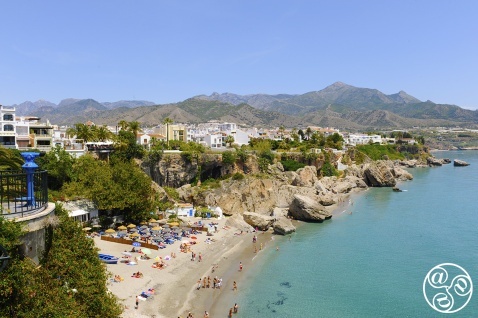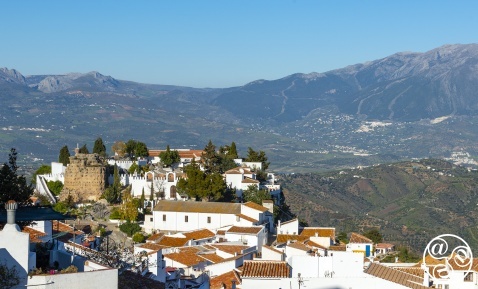
Handmade Ceramics from Axarquia |
|
About La Axarquia
It's hard to believe that the wild beauty of the La Axarquía is just half an hour from the coast of Málaga's eastern Costa del Sol. These villages are as interesting as the better-known white villages to the west and inland from the more glitzy western Costa del Sol including the gateway of Marbella. Nerja, to be fair, is the jewel in the crown of this eastern stretch Costa del Sol coastline. It has maintained a certain old-fashioned charm with its magnificent palm-lined Balcón de Europa, justly famed as one of the most beautiful promenades on the Coast.
It is inland from here, however, where the Axarquía unfolds in all its glory. Taking the motorway east from Málaga towards Motril and Almeria, follow the signs to Vélez-Málaga, one of the last Moorish strongholds to fall to Christian forces. The town's restored Muslim castle is worth some Instaposts, but otherwise move on, unless your visit falls on a Wednesday when there is a lively street market.
For a personal service from start to finish and afterwards too. Give us a call +34 618 295 063
It is the Axarquía interior, to the north from here, that is so stunning, stretching back from the sea and up towards the hills marking the border with Las Alpujarras. The two regions have more in common than the mere prettiness of their countryside. They have been historically entwined since 1569 when locals joined Granada's Morisco rebellion against a repressive decree declared by Felipe II two years earlier. This forbade the use of Arabic names and dress, and even the Arabic language. Virtually the entire Axarquía population was deported to western Andalucía and Castile in the centre of Spain, and the villages and towns were re-populated with folk from northern Spain. There were more tough times to come when, centuries later, the area became the notorious haunt of bandoleros who preyed upon traders carrying produce from Granada to the coast.
As is true throughout much of the province, the influence of the Moorish legacy in the Axarquía is apparent in the ingenious irrigation system built some seven hundred years ago. Today, this area is one of the most agriculturally-lush regions in the south of Spain. Its sub-tropical climate contributes in no small part to a terrain where it seems anything will grow: there are groves of avocado, citrus, pomegranate, mangoes, plus the more unusual kiwi, lychees and sugar-cane. Nearly all the villages that dot the olive-, almond- and vine-planted hillsides similarly reflect Muslim roots through their web of whitewashed, narrow streets, ancient archways, patios and wells.
Visually stunning, this bleached dazzle of villages seems almost luminescent against the looming dark backdrop of the Sierra Tejeda mountains. In the foreground there are brilliant brush-strokes of colour - red poppies, yellow mimosa, wild orchids -tempered by the cool green of olive groves and occasional splashes of pale pink almond blossom. And, if this Impressionist paint palette isn't sufficient assault on the senses, there is the natural potpourri of fragrances: pine, wild thyme, rosemary, lavender and a profusion of other herbs. This mountain range is also home to possibly the most beautiful natural park in Málaga province. The Sierra Almijara sectioin features its impressive bird and animal life, including vultures, eagles, bee-eaters, badgers and endemic curly-horned goats.
La Axarquía is understandably popular with walkers. Most of the region's walks follow dirt tracks created by the local Forestry Commission. There are also narrow, well-marked footpaths; you can pick up leaflets and maps from the local tourist offices. Alternatively, Comares (see below) is the starting point for several well-marked walks which are mapped out on a large plaque in its lower car park.
La Axarquia area is still breathtakingly beautiful and has not been spoilt by the interest and influx of foreigners. The main attractions are the area's dramatic hill and mountain scenery, its… More →
La Axarquia has much to offer in the way of rural tourism. The striking landscapes, vast expanses of unspoilt mountains, forests and rivers make for a wonderful exploratory visit. For families,… More →
It's hard to believe that the wild beauty of the La Axarquía is just half an hour from the Caleta de Vélez (or Málaga's Costa Oriental) - an uninspired coastal strip of down-trodden buildings and… More →
The natural parks of La Axarquia include Sierras of Tejeda, Almijara and Almara, Montes de Malaga Natural Park. Another natural bueaty spot is Lake Viñuela.
It's hard to believe that the wild beauty of the La Axarquía is just half an hour from the coast of Málaga's eastern Costa del Sol. These villages are as interesting as the better-known white… More →
Lake Viñuela is set in the stunning landscape of the Axarquia in Malaga province. Less than an hour’s drive from Malaga International Airport, La Viñuela is a very popular destination for those… More →
The bustling market town of Vélez-Málaga lies 5 km inland from Torre del Mar, surrounded by subtropical vegetation. Capital of La Axarquía, Vélez-Malaga, often simply referred to as Vélez, is the… More →
Tourist routes
If you are travelling with wheels, there are similar colour-coded routes that have been devised to boost rural tourism. The Ruta del Sol y del Aguacate (the Sun and Avocado Route) starts at Rincón de la Victoria and visits the Veléz valley, including Macharaviaya, Benomocarra and Iznate. The Ruta del Sol y del Vino (the Sun and Wine Route) starts on the coast in Nerja and includes the main wine-producing villages. The Ruta Mudéjar concentrates on architecture, passing through villages such as Salares and Sedilla. The Ruta del Aceite y los Montes (the Route of the Oil and the Mountains) examines the olive-growing villages, including Periana and Alaucín. Finally, the Ruta de la Pasa (the Route of the Raisin) includes the more mountainous villages, such as spectacular Comares in the north-west.
Comares
If you only visit one village here, Comares is a good and representative choice. One of the highest pueblo blancos in Andalucía (739 metres above sea level), Comares can be spied for miles around, rising high above the surrounding countryside and resembling a natural extension of its craggy rock face. A map is useful, although first-time visitors may still find the approach hard to find. Equally baffling is the fact that the village keeps disappearing from view as the winding country roads dip and curve around a succession of death-defying hairpin bends. Fortunately, despite being breathtakingly dramatic, Comares has not yet succumbed to the coach-tours. There is a handful of foreign residents living here.
Throughout the village there are colourful ceramic plaques depicting Comares' important place in a history that dates back to the third century BC. Folklore is also depicted Comares leads the way in a local flamenco-like folk music called Verdiales. The village was one of the principle defensive bastions of Omar Ben Hafsun. During the early times of the Moorish caliphs in Cordoba, it protected what are now the ruins of the local capital on the Mazmullar plateau, some four kilometres from the village and well worth a visit.
One of the towers that reinforced Comares' walls still exists, next to the cemetery at the top of the village. The view in all directions is incredible. To the south, rolling hills of olive and almond trees reach to the sea while, to the north, dramatic mountains rise up far into the distance, a bewitching lunar landscape shifting and changing according to the light. Strategically important in the defence of the crumbling Moorish territories, Comares was finally conquered by the Catholic Kings from the north in 1487.
The village remains typically Moorish in its layout, with narrow cobbled streets interspersed by arches - two of which are thought to date back to medieval times - and flanked by simple whitewashed houses. The parish church is 16th-century, with a striking wood-vaulted ceiling. There are also four bars, two plazas, two supermarkets, two banks and a post office. At the time of writing, you still can't buy an "I Love Comares" T-shirt here yet but instead will have to settle for taking home a bottle of local wine. If you are serious about the latter, head for Cómpeta, located at the heart of vineyard country.
Cómpeta
Cómpeta is a charming flower-bedecked old town with its main centre, the Plaza Almijara, dominated by a magnificent sixteenth-century church. This bustling square is one of the best places to enjoy a break, with a choice of several bars and restaurants. The town is self-sufficient and thriving, its municipal market providing its three thousand inhabitants with a fresh daily supply of meat, fish and vegetables.
One of Cómpeta's most popular annual fiestas is the Noche del Vino (Night of the Wine) on August 15th. This features a programme of flamenco, and sevillana music and dance, plus plenty of free-flowing vino. Fittingly, the town has a "Museo del Vino" - which also sells locally-made crafts such as ceramic ware and rugs - where you can indulge in a serious tasting session.
West of Cómpeta, a scenic road winds through the villages of Salares, Sedella and Canillas de Aceituna, eventually linking up with the A-335 north of Vélez-Málaga. Alternatively, take the road south-west from Árchez to Arenas, where a steep but driveable track climbs to the ruined moorish Castillo de Bentomiz, crowning a hilltop with still more stunning panoramas.





